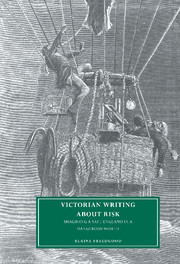Book contents
- Frontmatter
- Contents
- List of illustrations
- Acknowledgments
- Introduction: the practice of paradise
- 1 Banishing panic: J. R. McCulloch, Harriet Martineau and the popularization of political economy
- 2 The rhetoric of visible hands: Edwin Chadwick, Florence Nightingale and the popularization of sanitary reform
- 3 Groundless optimism: regression in the service of the ego, England and empire in Victorian ballooning memoirs
- 4 The uses of pain: cultural masochism and the colonization of the future in Victorian mountaineering memoirs
- 5 A field for enterprise: the memoirs of David Livingstone and Mary Kingsley
- Conclusion
- Notes
- Bibliography
- Index
- CAMBRIDGE STUDIES IN NINETEENTH-CENTURY LITERATURE AND CULTURE
5 - A field for enterprise: the memoirs of David Livingstone and Mary Kingsley
Published online by Cambridge University Press: 06 September 2009
- Frontmatter
- Contents
- List of illustrations
- Acknowledgments
- Introduction: the practice of paradise
- 1 Banishing panic: J. R. McCulloch, Harriet Martineau and the popularization of political economy
- 2 The rhetoric of visible hands: Edwin Chadwick, Florence Nightingale and the popularization of sanitary reform
- 3 Groundless optimism: regression in the service of the ego, England and empire in Victorian ballooning memoirs
- 4 The uses of pain: cultural masochism and the colonization of the future in Victorian mountaineering memoirs
- 5 A field for enterprise: the memoirs of David Livingstone and Mary Kingsley
- Conclusion
- Notes
- Bibliography
- Index
- CAMBRIDGE STUDIES IN NINETEENTH-CENTURY LITERATURE AND CULTURE
Summary
… Geographers in Afric-Maps
With Savage-Pictures fill their Gaps…
Jonathan Swift, On PoetryThe previous two chapters explored the pleasures of risk as recounted in the memoirs of balloon aeronauts and the pains of risk as represented in the memoirs of Alpine mountaineers. This chapter will concern the effects of two writers whose work effectively dismantled ideas about the severity and ubiquity of risk in the most dangerous place in the dangerous world as it was imagined in Victorian Britain: Africa. David Livingstone's Missionary Travels and Researches (1857) and Mary Kingsley's Travels in West Africa (1897) work to illuminate the “dark continent” and render it less threatening and hazardous than the dominant Victorian discourse of Africa suggested. Livingstone, as a laboring-class Victorian, and Kingsley, as a female Briton, create (because of the exigencies they experienced at “home” as a result of their class and gender) an alternative discourse of Africa. They implicitly direct their readers to a safer Africa, a place in which Britons like themselves could risk subjective expansion in a way that had been impossible for them at home: it becomes what Mary Kingsley calls in West African Studies (1899) “a field for enterprise.” This subjective expansion is the latent content of their narratives; the manifest content of both texts is the geographical expansion that each writer accomplishes in his or her explorations of previously unknown (by Europeans) or little-known areas.
- Type
- Chapter
- Information
- Victorian Writing about RiskImagining a Safe England in a Dangerous World, pp. 132 - 169Publisher: Cambridge University PressPrint publication year: 2000



